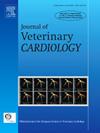Atrial depolarization electrocardiographic features during orthodromic atrioventricular reciprocating tachycardia mediated by right-sided accessory pathway in the dog
IF 1.3
2区 农林科学
Q2 VETERINARY SCIENCES
引用次数: 0
Abstract
Introduction/Objectives
Electrocardiographic features of atrial depolarization (AD) during orthodromic atrioventricular reciprocating tachycardia (OAVRT) have been widely studied to localize accessory pathways (APs) in humans. The aim of this study was to determine whether AD characteristics might also be used to determine AP anatomical sites in dogs.
Animals, Materials and Methods
Clinical records for 83 dogs that underwent electrophysiologic studies for AP ablation were retrospectively analyzed. Accessory pathways were classified into three groups according to localization: right anterior (RA, 13.3%), right postero-septal (RPS, 36.1%), and right posterior (RP, 50.6%). Electrocardiographic characteristics of AD (duration, amplitude, and axis) and OAVRT (AD-AD, peak of R wave - atrial depolarization (R-AD)/atrial depolarization - peak of R wave (AD-R), peak to peak of R wave (RR) interval, and QT duration) were analyzed in all 12 leads.
Results
Mean AD duration in RA, RPS, and RP was 48.0 ± 10.3 ms, 46.1 ± 10.6 ms, and 47.1 ± 10.2 ms, respectively, and the mean amplitude was −0.25 ± 0.12 mV, −0.28 ± 0.20 mV, and −0.28 ± 0.18 mV, respectively. The median electrical axis on the frontal plane was −90.0° (interquartile range [IQR]: 26.5° in RA, 9.4° in RPS, and 13.9° in RP). The median AD-R, mean R-AD intervals, and mean R-AD/AD-R were 140.0 ms (IQR: 34.5 ms), 72.0 ± 19.3 ms, and 0.50 ± 0.14 in RA; 138.0 ms (IQR: 33.0 ms), 76.5 ± 13.6 ms, and 0.55 ± 0.15 in RPS; and 121.0 ms (IQR: 20.0 ms), 74.1 ± 11.7 ms, and 0.59 ± 0.15 in RP. No others statistically significant differences in electrocardiographic parameters were found.
Study Limitations
Identification of ADs in some dogs was not straightforward, and thoracic conformation differences may have affected AD measurements.
Conclusions
Electrocardiographic features of AD during OAVRT are not useful for localizing right-sided APs in dogs.
犬右侧副通路介导的房室往复式心动过速的心房去极化心电图特征
导读/目的在人类正畸型房室往复式心动过速(OAVRT)期间心房去极化(AD)的心电图特征已经被广泛研究以定位辅助通路(APs)。本研究的目的是确定AD特征是否也可以用于确定狗的AP解剖部位。动物、材料和方法回顾性分析83只接受AP消融电生理检查的犬的临床记录。附属通路根据定位可分为3组:右前路(RA, 13.3%)、右后间隔(RPS, 36.1%)和右后路(RP, 50.6%)。分析12例导联AD的心电图特征(持续时间、振幅、轴向)和OAVRT (AD-AD、R波峰-心房去极化(R-AD)/心房去极化-R波峰(AD-R)、R波峰间期(RR)、QT间期)。结果RA、RPS、RP组平均AD持续时间分别为48.0±10.3 ms、46.1±10.6 ms和47.1±10.2 ms,平均振幅分别为- 0.25±0.12 mV、- 0.28±0.20 mV和- 0.28±0.18 mV。额平面电轴中位数为- 90.0°(四分位间距[IQR]: RA为26.5°,RPS为9.4°,RP为13.9°)。RA的中位AD-R、平均R-AD间隔和平均R-AD/AD-R分别为140.0 ms (IQR: 34.5 ms)、72.0±19.3 ms和0.50±0.14;RPS分别为138.0 ms (IQR: 33.0 ms)、76.5±13.6 ms和0.55±0.15 ms;和121.0 ms (IQR: 20.0 ms), 74.1±11.7 ms, 0.59±0.15的RP。在心电图参数方面没有发现其他统计学上的显著差异。研究局限性:在一些狗身上识别AD并不简单,胸廓构象的差异可能会影响AD的测量。结论OAVRT时AD的心电图特征对犬右侧APs的定位没有帮助。
本文章由计算机程序翻译,如有差异,请以英文原文为准。
求助全文
约1分钟内获得全文
求助全文
来源期刊

Journal of Veterinary Cardiology
VETERINARY SCIENCES-
CiteScore
2.50
自引率
25.00%
发文量
66
审稿时长
154 days
期刊介绍:
The mission of the Journal of Veterinary Cardiology is to publish peer-reviewed reports of the highest quality that promote greater understanding of cardiovascular disease, and enhance the health and well being of animals and humans. The Journal of Veterinary Cardiology publishes original contributions involving research and clinical practice that include prospective and retrospective studies, clinical trials, epidemiology, observational studies, and advances in applied and basic research.
The Journal invites submission of original manuscripts. Specific content areas of interest include heart failure, arrhythmias, congenital heart disease, cardiovascular medicine, surgery, hypertension, health outcomes research, diagnostic imaging, interventional techniques, genetics, molecular cardiology, and cardiovascular pathology, pharmacology, and toxicology.
 求助内容:
求助内容: 应助结果提醒方式:
应助结果提醒方式:


